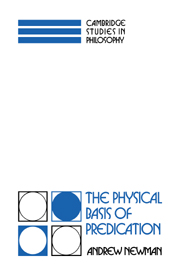Book contents
- Frontmatter
- Contents
- Acknowledgements
- Introduction
- Chapter 1 “Real constituents of the world”
- Chapter 2 What can logic and language tell us about reality?
- Chapter 3 The “existence” of universals and the notion of possibility
- Chapter 4 The causal significance of basic attributes
- Chapter 5 Hierarchies of universals
- Chapter 6 Causal relations
- Chapter 7 Arbitrary particulars and unified particulars
- Chapter 8 Further considerations concerning the causal relation
- Chapter 9 Arbitrary particulars and physical objects
- Bibliography
- Index
Chapter 9 - Arbitrary particulars and physical objects
Published online by Cambridge University Press: 04 May 2010
- Frontmatter
- Contents
- Acknowledgements
- Introduction
- Chapter 1 “Real constituents of the world”
- Chapter 2 What can logic and language tell us about reality?
- Chapter 3 The “existence” of universals and the notion of possibility
- Chapter 4 The causal significance of basic attributes
- Chapter 5 Hierarchies of universals
- Chapter 6 Causal relations
- Chapter 7 Arbitrary particulars and unified particulars
- Chapter 8 Further considerations concerning the causal relation
- Chapter 9 Arbitrary particulars and physical objects
- Bibliography
- Index
Summary
SETS AS ARBITRARY PARTICULARS
Although the criterion of identity for a set may be clear, it is not clear what a set is. It is not clear in what sense a set is one thing, or what it is that binds its elements together to make it one thing. A number of attempts have been made to answer this question, but unfortunately none of them appears to be very satisfactory. By reviewing some of these answers I shall try to show that sets of particulars deserve to be called arbitrary particulars. The basis of my discussion will be Max Black's discussion of the nature of sets as collections, as abstract objects, and as examples of plural reference.
The elements of a set have to be sharply demarcated things. It has to be made clear that it is the copse that is to be the element of the set, and not the five trees as trees that make up the copse; and it has to be made clear that it is the material object as such and not its constituent parcel of matter that is to be the element of the set. Each element must therefore have associated with it an unambiguous criterion of identity. And since each type of particular has its own criterion of identity, if follows that an element of a set enters into membership only as a particular of a certain type.
- Type
- Chapter
- Information
- The Physical Basis of Predication , pp. 208 - 256Publisher: Cambridge University PressPrint publication year: 1992



